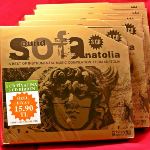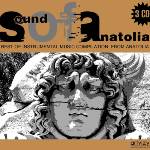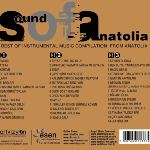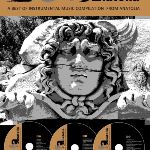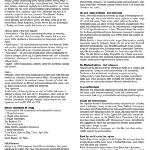
Songs
- artist:Various (Instrumental)
- featured artist:Various (Instrumental)
- release year:2011
- style(s):Folk, Instrumental
- country:Türkiye
- formats:Audio File / Digital, CD (Compact Disc)
- record posted by:Artvizyon Music&Film
- label:Artvizyon Music&Film
- publisher:Artvizyon Music&Film
- buy this record
SOFA (Sound Of Anatolia)
A Best Of Instrumental Music From Anatolia- 3 CD
This 3 CD BOX-SET includes 42 instrumental tracks with full orchestra consist of ethnical folk instruments.
Anatolian Folk Music
Varieties of style, scales, and rhythm
Music accompanied by words can be classified under the following headings: Turku (folksongs), Kosma (free-form folk songs about love or nature), Semai (folk song ın Semai poetic form), Mani (a traditional Turkish quatrain form), Destan (epic), Deyis (speech), Uzun Hava (long melody), Bozlak (a folk song form), Agit (a lament), Hoyrat, Maya (a variety of Turkish folksong), Bogaz Havasi (throat tune), Teke Zorlatmasi, Ninni (lullaby), Tekerleme (a playful form in folk narrative), etc. These are divided into free-forms or improvisations with no obligatory metrical or rhythmic form, known as "Uzun Hava", and those that have a set metrical or rhythmic structure, known as "Kirik Havalar" (broken melodies). Both can also be employed at the same time.
Music generally played without words, and dance tunes, go by the names Halay, Bengi, Karsilama, Zeybek, Horon, Bar, etc. Each region in Turkey has its own special folk dances and costumes.
Here are some of the most popular:
• Horon (Hora) - This Black Sea dance is performed by men only, dressed in black with silver trimmings. The dancers link arms and quiver to the vibrations of the kemenche (an instrument similar to violin).
• Kasik Oyunu - The Spoon Dance is performed from Konya to Silifke and consists of gaily dressed male and female dancers 'clicking' out the dance rhythm with a pair of wooden spoons in each hand.
• Kilic Kalkan - The Sword and Shield Dance of Bursa represents the Ottoman conquest of the city. It is performed by men only, in Ottoman battle-dress, who dance to the sound of clashing swords and shields, without music.
• Zeybek - In this Aegean dance, dancers, called "efe", symbolize courage and heroism.
Scales
Although Turkish folk music melodies possess the same note and scale modules as traditional Ottoman Classical Music, the melodies known as makam (similar to the medieval concept of mode) in Turkish folk music can be known by different names depending on the region, such as: Besiri, Garip, Kerem, Misket, and Müstezad.
Time signatures
A wide variety of time signatures are used in Turkish folk music. In addition to simple ones such as 2/4, 4/4 and 3/4, others such as 5/8, 7/8, 9/8, 7/4, and 5/4 are common. Combinations of several basic rhythms often results in longer, complex rhythms that fit into time signatures such as 8/8, 10/8, and 12/8.
Musical instruments of Turkey
Turkish musical folk instruments can be classified as follows:
1. String Instruments
a) Played with a plectrum
b) Played with fingers
Saz, Baglama, Tar
2. Bow Instruments
Kabak Kemane, Karadeniz Kemencesi
3. Wind Instruments
Zurna, Kaval, Cigirtma, Mey, Tulum, Sipsi, Cifte
4. Percussion
Davul, Nagara, Tef, Kasik
Folk Literature
A large body of folk songs are derived from minstrels or bard-poets called ozan in Turkish. They have been developing Turkish folk literature since the beginning of 11th century. The musical instrument used by these bard-poets is the saz or baglama. They are often taught by other senior mistrels, learning expert idioms and procedure and methods about the performance of the art. These lessons often take place at minstrel meetings and coffeehouses frequented by them. Those bard-poets who become experts or alayli then take apprentices for themselves and continue the tradition.
A minstrel's creative output usually takes two major forms. One, in musical rhyming contests with other bards, where the quarrel ends with the defeat of the minstrel who cannot find an appropriate quatrain to the rhyme and two, story telling. These folk stories are extracted from real life, fokelore, dreams and legends. One of the most well-known followings are those bards that put the title asik in front of their names.
Religious music
Mosque music
"Mosque music," a term for music associated with mainstream religion in Turkey, includes ezan (call-to-prayer), Kur'an-i Kerim (Koran recitation), Mevlit (Ascension Poem), and ilahi (hymns usually sung in a group, often outside a mosque). On musical grounds, mosque music in large urban areas often resembles classical Turkish music in its learned use of makam and poetry.,
The Ashik traditions- Alevi Influences
Alevis, whose folk music is performed by a type of travelling bard or ozan called asik, who travels with the saz or baglama, an iconic image of Turkish folk music. These songs, which hail from the central northeastern area, are about mystical revelations, invocations to Alevi saints and Muhammad's son-in-law, Ali, whom they hold in high esteem. In Turkish asik literally means 'in love'. Whoever follows this tradition has the Asik assignation put before their names, because it is suggested that music becomes an essential facet of their being, for example as in Ashik Veysel.
Middle Anatolia is home to the bozlak, a type of declamatory, partially improvised music by the bards. Neset Ertas has so far been the most prominent contemporary voice of Middle Anatolian music, singing songs of a large spectrum, including works of premodern Turkoman asiks like Karacaoglan and Dadaloglu and the modern asiks like his father, the late Muharrem Ertas. Around the city of Sivas, asik music has a more spiritual bent, afeaturing ritualized song contests, although modern bards have brought it into the political arena.
The Mevlevi traditions - Sufi Influences
Followers of the Mevlevi Order or whirling dervishes are a religious sufi sect unique to Turkey but well-known outside of its boundaries.
Dervishes of the Mevlevi sect simply dance a sema by turning continuously to music that consists of long, complex compositions called ayin. These pieces are both preceded and followed by songs using lyrics by the founder and poet Mevlana Jelaleddin Rumi.
Regional folk styles
Minorities and indigenous peoples have added and enhanced Turkish folk styles, while they have adopted Turkish folk traditions and instruments. Folk songs are identifable and distinguished by regions.
Aegean and Rumeli regions
The region of Rumeli or Roumelia is used to indicate the part of Turkey which is in Europe, namely provinces of Edirne, Kirklareli, Tekirdag and the western part of Istanbul Province. Folk songs from this region share similarities with Balkan and Greek folk music, especially from the ethnic minorities and natives of Thrace. Cypriot folk music also shares folk tunes with this region, e.g. the Ciftetelli dance. These type of folk songs also share close similarities with Ottoman court music, strengthening the suggestion by some that the distinction between court and folk music wasn't always so clear.
The Turkish islands in the Aegean and cities like Izmir share similar motifs, such as the Zeybek dance.
Black Sea and Caspian Sea regions
Central Asian Turkic peoples from the Caspian Sea and areas have had a huge influence in the purest forms of Turkish folk music, most notably from the Azeris and Turkmen.
Pontic Greeks on the eastern shore of the Black Sea or Karadeniz regions have their own distinct style of folk music, motifs from which were used with great success by Helena Paparizou. The diaspora of Greek speaking Pontic people from that region introduced Pontic music to Greece after 1924 population exchange between Turkey and Greece. The region's dance style uses unique techniques like odd shoulder tremors and knee bends.
Southeastern regions
Southeastern regions carry influences from Turkmen music, Kurdish music, Zaza motifs and Armenian music. These usually include epic laments.


